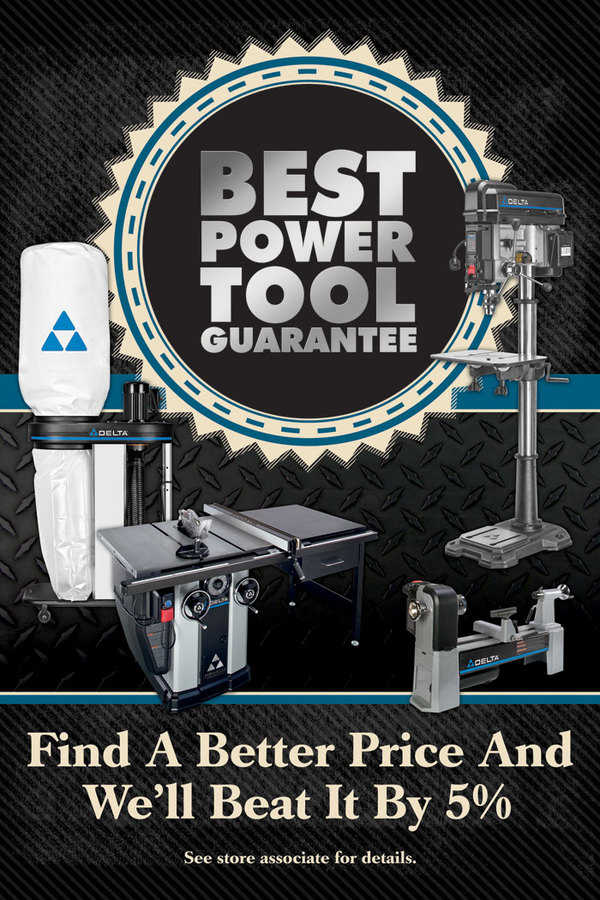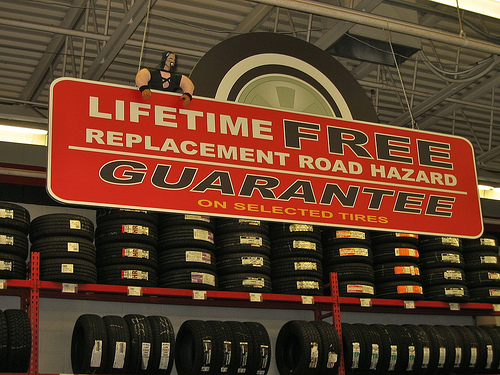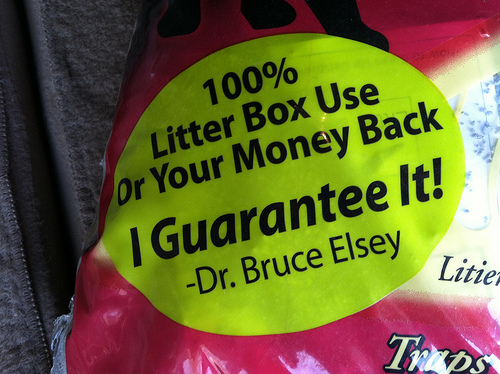Guarantee Marketing: How to Write the Ultimate Offer

If there’s one negative thing that people tend to associate with Domino’s, it’s that their pizza isn’t very good. That’s usually kind of a dealbreaker when you’re in the business of selling pizza, but the company turned it around by marketing one irresistible service guarantee with low risk and high reward: “30 minutes or less, or it’s free.” Though the deal was eventually discontinued, it helped put Domino’s on the map as one of the most successful pizza companies in the world.
Guarantees are a vital weapon in your marketing arsenal, but it’s important to know how to write them effectively so that prospects take notice (and take action). The following strategies will help you make your audience an offer they can’t refuse.
-
Address your audience’s concerns
Begin by establishing why you’re making a guarantee to your audience. What is it about your product or service that might make your consumers uneasy? To be most effective, your offer should address these concerns. For example, if your audience is particularly concerned that your product might not work, a deal that promises results or their money back is a great idea.
You may want to conduct a study amongst a sample of your consumers to determine the specific pain points your guarantee should address–cost, effectiveness, time, or another factor altogether.
-
Keep it simple and easy
Guarantees work best when they’re as simple as possible. The more things your customer has to do to redeem the guarantee, the less likely they’ll be to convert. If, for instance, you write your return policy as “Send the product back for a full refund,” you’ll probably get less response than if you said “Call us for a full refund” because the action you’re asking of them requires less time and money.

This poster establishes the guarantee and offers a very simple call to action: ‘See store associate for details.’ Photo Credit: Amy Nelson
Make sure that the terms of your offer are direct and easy to understand. A basic instruction to get in touch with your company (via phone or e-mail) is best; if there are further details to deal with, a customer service representative can handle them.
Remove roadblocks from your guarantee’s process wherever you can. For example, when you send someone a packaged order, consider including a return slip to make it easier for buyers to return the product if they choose to do so. Even if you lose a sale, you’ll have earned customer loyalty and word of mouth marketing; people appreciate a company that’s easy to work with and they’re likely to recommend it to others.
-
Use risk reversal
Any purchase a consumer makes comes with a certain amount of risk–risk that the product might not be effective, stop working after a few weeks, come with extra hidden fees, etc. These risks can keep customers from converting. Risk reversal helps to minimize this effect by putting the risk on you rather than your audience, providing them with an immediate incentive to buy.
Risk reversals typically go above and beyond a “30-day money-back guarantee.” For many buyers, this sort of standard return policy won’t do much to attract them because they find it tedious and not worth the effort.
To truly incentivize your guarantee, you may want to provide a reward that’s greater than the risk (similar to the Domino’s deal in our original example). One possibility is a return premium where customers making a return receive more than they originally paid. If your audience realizes that they’ll gain something even better if something goes wrong, they’ll soon realize that they’d be crazy not to buy.

This sign is meant to be a joke (which is apparent once you read it carefully), but it demonstrates the attention-grabbing power of an apparent benefit that outweighs the risk. Photo Credit: Flickr user slworking2
Some consumers may take advantage of this sort of guarantee, but your increase in conversions is likely to outweigh the scammers. If you use a return premium where consumers get to keep the product they purchased, they may find that they like it more over time and recommend it to friends and family. Don’t be too concerned about a generous return policy; many consumers are too proud to return an item even if they don’t like it. It’s often surprising how far we’ll willing to go to justify our purchases to ourselves.
You can reduce your investment further by providing a gift that’s of low cost to your business such as overstock items. Alternatively, reach out to other businesses to partner up on offers. For example, some companies might be willing to provide free promotional gifts that you can provide to customers making a return.
-
Reduce restrictions and conditions
Avoid loading up your marketing guarantees with a bunch of caveats and legal mumbo-jumbo if you can help it. People tend to get cagey arounda lot of asterisks and fine print; they can make your promise look untrustworthy and risky.
Try to write a guarantee with as few restrictions as possible. People are likely to skip right over an offer like “If you don’t like our product, we’ll refund your money within 30 days if you still have your receipt, the original packaging, the product number, the date of purchase…..” and so on.
What if conditions are necessary?
Sometimes you need to qualify your guarantee with conditions or restrictions and there’s just no getting around it. In cases like this, make sure that those conditions are perfectly clear and easy to understand. Don’t fudge the truth; misleading your audience (even unintentionally) won’t do you any favors.

Sometimes conditions (such as ‘only on selected products’) are unavoidable, but there are ways of managing them effectively. Photo Credit: Flickr user pecooper98362
To lessen the “blow” of a conditional guarantee, try pairing it with an additional short, simple and unconditional one. For instance: “If you don’t like the product, return it within 30 days for a full refund. If the product ever breaks, we’ll replace it for free.” The satisfaction guarantee has a condition that it can only be redeemed within 30 days, but the follow-up guarantee comes with no apparent strings attached, making the deal much more attractive.
You can also sometimes turn a condition into part of the deal itself. For example, instead of providing a 30-day window for returns, let customers use the product for 30 days and only charge them if they don’t return the product in that time. The end result is the same, but you’ll see more conversions because the restriction is instead presented as a benefit.
-
Incorporate the product’s benefits
Give your audience more detail about your brand by incorporating parts of your brand message directly into your offer. Instead of just saying “Return SkinSolution for a full refund if you’re unsatisfied” in your marketing, you may want to write it as “If SkinSolution doesn’t give you clearer, creamier skin after three months, return it for a full refund!” This way, the customer learns about your product’s benefits at the same time they learn about your offer.
Listen to the way the copywriting in this TV spot for a clothing company ties a “100-day guarantee” directly into the brand’s reputation for high-quality products.
-
Highlight the guarantee in your design
No one will take advantage of your deal if they don’t notice it on the page. Make sure your guarantee stands out and is easy to scan.
You can use the basic principles of emphasis in design to draw extra attention towards your offer. Try highlighting key words and phrases with bold fonts or brightly colored text such as red.
Unsatisfied with your purchase? Call us for a full refund.
Also consider surrounding the guarantee with a sharp border or extra whitespace for even more emphasis.
-
Give your guarantee a face
A promise is much more trustworthy when you can see the person it’s coming from. In fact, research has suggested that the way a person’s face looks matters even more than their business reputation when it comes to making financial decisions.
Give credibility to your claim by including a smiling photo of your company’s spokesperson, whether that’s the CEO or an employee in public relations. This will make your guarantee more engaging and attractive to potential customers.
Even if you can’t incorporate a photograph into your marketing materials, you can add credibility by including a name that suggests authority or expertise. If you’re assuring people of the quality of cat litter, for example, try including a testimonial from someone who can back up your claim, such as a veterinarian.

This guarantee has extra weight because it’s endorsed by a doctor who can qualify the claim. Photo Credit: PersuasionTheory
-
Keep your promises
There’s a classic Kids in the Hall sketch about the so-called “King of Empty Promises” who makes increasingly lavish guarantees but doesn’t follow through with any of them (to the great frustration of everyone around him). A promise that you don’t keep will hurt your image much more than if you had never made the promise to begin with. What’s more, making an offer that you don’t honor will lessen the impact of any guarantees you attempt to make in the future.
For that reason, you should always make every effort to follow through on your company’s promises. This includes delivering on what you say your product or service will accomplish for your audience. Make sure you know your product and how customers tend to respond to it before making any related promises.
For example, before you guarantee that your laundry detergent will remove even the toughest stains, you’d better be aware of just how effective the detergent is and how tough those stains have the potential to be.
Conclusion
The higher the risk associated with your product or service, the more effect a good guarantee will have. This makes them especially useful when selling products that require a large investment of money or time. Use these strategies anytime you need to turn a high-risk scenario into a truly irresistible offer.
Have you ever seen a marketing guarantee that made you do a double take? Write your stories, ideas and other thoughts in the comments below.
Posted in Copywriting, Marketing, Marketing Ideas
Don`t neglect your friends, share this right away.





Leave a Reply